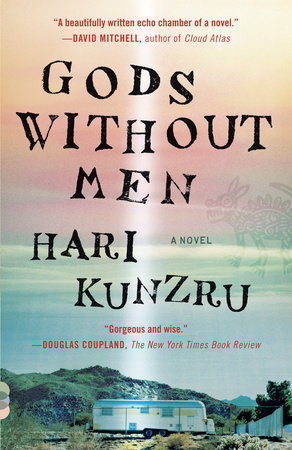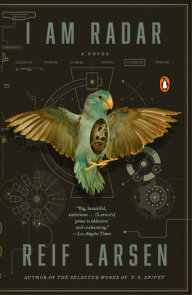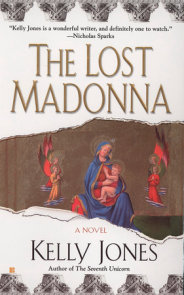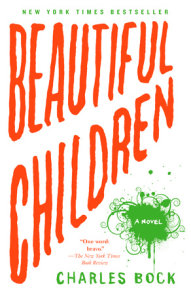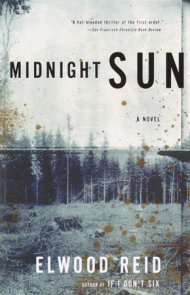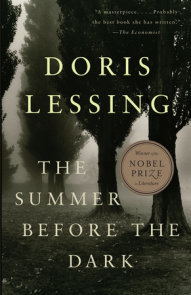READERS GUIDE
The questions, discussion topics, and reading list that follow are intended to enhance your reading group’s discussion of Gods Without Men, Hari Kunzru’s viscerally gripping and intellectually engaging novel about the human impulse to search for meaning in a chaotic universe.Introduction
A kaleidoscopic novel that shifts between a modern-day couple’s struggle to come to terms with their son’s inexplicable disappearance in the Mojave Desert and the epiphanies of the restless spirits who ventured there before them, Gods Without Men delivers an acute portrait of contemporary American life as it illuminates the timeless human desire to comprehend life’s mysteries.Jaz and Lisa Matharu come to the desert with their autistic four-year-old son, Raj, hoping that time away from their stressful lives in New York City will heal their troubled marriage. But Jaz disappears during a sightseeing visit to an ancient rock formation known as the Pinnacles, where strange energies and extraordinary phenomena were witnessed in the past by Native Americans, religious zealots, and an extraterrestrial-worshipping cult. As Jaz and Lisa engage in a surreal and chaotic search for their missing son in which law enforcement authorities, the media, and the public vilify them, only they can determine if their extraordinary odyssey will end in madness or a joyful reunion.
Questions and Topics for Discussion
1. Gods Without Men brings us into the consciousness of nine fictional characters, among them a hedge fund executive; a UFO cult leader; a dissolute British rock star; a homesick Iraqi teenage girl; one historical character, the eighteenth-century Spanish missionary Fray Francisco Hermenegildo Tomás Garcés; and one deity, Coyote, the trickster in many Native American traditional stories. Why does Hari Kunzru embrace such a wide and diverse cast of characters?
2. Do these characters from different historical eras and different echelons of society share any of the same aspirations? What draws them to the Pinnacle Rocks?
3. Which character or characters do you most identify with? Why?
4. Why do you think Kunzru set this novel in the desert? Could he have told the same story in a different landscape?
5. After reading Gods Without Men do you agree with Honoré de Balzac’s description of the desert: “In the desert, you see, there is everything and nothing . . . It is God without men,” one of the epigraphs of this novel? Has your conception of the desert changed? Do you think “wasteland” is an appropriate synonym for “desert”?
6. Dawn joins the Ashtar Galactic Command in 1970 when she is a teenager because she wants “to be part of something bigger than herself” (page 155). Does she achieve that goal? Thirty-eight years later, teenage Laila draws comfort from the Ashtar record she buys at a thrift shop. Why?
7. Several characters in the novel possess arcane knowledge of mathematics, alchemy, aerodynamics, electrical engineering, or entertainment marketing that enables them to manipulate the material world in their favor, yet they don’t seem satisfied with their achievements. What are the sources and consequences of their dissatisfaction?
8. The character Coyote appears intermittently throughout the novel as an animal, a man, and a deity. What do his appearances herald? Are other characters comparably skilled at transforming themselves?
9. Kunzru references three international conflicts in this novel—World War I, World War II, and the second Iraq War. What do the characters Deighton, Schmidt, and Laila, who had firsthand experiences of those wars, have in common?
10. Lisa views Raj’s disappearance as her punishment for her wild night in town. Dawn thinks she was responsible because by taking Lisa to Judy’s place “she’d got her family involved. They were mixed up with Coyote, mixed up in the paths and flows” (page 343). Do you believe that either character is responsible for Raj’s disappearance?
11. Does the little glowing boy Laila finds in the desert at night (page 297) bear any relation to the “glow boy” (page 64) Joanie’s daughter, Judy, was seen playing with before she disappeared in 1958?
12. Why do you think Lisa is able to gratefully accept her son’s seemingly miraculous return and his recovery from autism, whereas Jaz cannot bear not knowing what happened to his son and is frightened by Raj’s changed behavior, believing the boy who was returned to them is not Raj; “It’s as if—as if something is wearing his skin” (page 357)?
13. Toward the end of the novel, Lisa believes she has learned a lesson: “true knowledge is the knowledge of limits, the understanding that at the heart of the world . . . is a mystery into which we are not meant to penetrate. . . . Now she could call it God . . . confident that though the world was unknowable, it had a meaning, and that meaning would keep her safe and set her free” (page 345). Does Jaz experience his own epiphany at the end of the novel when he stands holding hands with Lisa and Raj looking out over the desert?
14. Why does the novel begin and end with an explosion? At the end of the novel, do you gain a clearer understanding of what Coyote was up to in the first chapter?
15. Do you think Kunzru’s postmodernist storytelling technique of presenting the reader with pieces of a puzzle without providing explicit explanations of how the pieces fit together is appropriate for a novel that explores the search for pattern and meaning? Would the story be more or less realistic if he had limited himself to traditional forms of storytelling?







